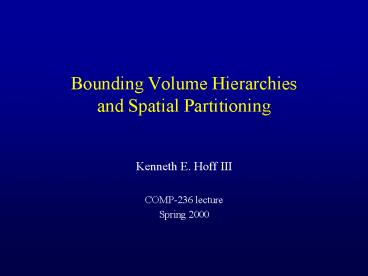Bounding Volume Hierarchies and Spatial Partitioning PowerPoint PPT Presentation
Title: Bounding Volume Hierarchies and Spatial Partitioning
1
Bounding Volume Hierarchiesand Spatial
Partitioning
- Kenneth E. Hoff III
- COMP-236 lecture
- Spring 2000
2
Introduction
- Bounding Volume Hierarchies vs. Spatial
Partitioning - What are they and how do they compare?
- Motivation Need for Speed!
- Demonstration through applicationsView-frustum
culling, ray-tracing, collision detection - How can hierarchies help?
- Apply to example applications
- Building bounding volume hierarchies
- Building spatial partitionings
- Whats the best choice?
- Can we do better?
3
What are they? How do they Compare?
- Bounding Volume Hierarchies
- Hierarchical object representation
- Object subdivision
- Hierarchical clustering of objects
- Object levels of detail
- Classifies regions of space around objects
- Examples
- OBB-trees
- AABB-trees
- Sphere-trees
- k-DOPs
- Spatial Partitioning
- Hierarchical spatial representation
- Spatial subdivision
- Hierarchical clustering of space
- Spatial levels of detail
- Classifies objects around regions of space
- Examples
- Uniform grids
- Quadtrees Octrees
- BSP-trees
- kD-trees
4
Examples
- Bounding Volume Hierarchies
- Tightly fits objects
- Redundant spatial representation
- Spatial Partitioning
- Tightly fills space
- Redundant object representation
5
Examples
- Bounding Volume Hierarchies
- Tightly fits objects
- Redundant spatial representation
- Spatial Partitioning
- Tightly fills space
- Redundant object representation
Volumes overlap multiple objects
Objects overlap multiple volumes
6
Examples
- Bounding Volume Hierarchies
- Tightly fits objects
- Redundant spatial representation
- Spatial Partitioning
- Tightly fills space
- Redundant object representation
Volumes overlap multiple objects
Objects overlap multiple volumes
7
Examples
- Bounding Volume Hierarchies
- Tightly fits objects
- Redundant spatial representation
- Spatial Partitioning
- Tightly fills space
- Redundant object representation
Volumes overlap multiple objects
Objects overlap multiple volumes
8
Motivation Example Applications
- View-frustum culling O(n)
Ray-tracingO(n) per ray
Collision detectionO(n2)
9
How do we speed it up?
- More efficient intersection calculations
- Avoid intersection calculations
- Make a single intersection calculation to
decidefor an entire cluster of objects or space - Cluster hierarchically
10
How can bounding volume hierarchies help?
- View-frustum culling
Ray-tracing
Collision detection
11
How can bounding volume hierarchies help?
- View-frustum culling
Ray-tracing
Collision detection
12
How can bounding volume hierarchies help?
- View-frustum culling
Ray-tracing
Collision detection
13
How can bounding volume hierarchies help?
- View-frustum culling
Ray-tracing
Collision detection
14
How can bounding volume hierarchies help?
- Logarithmic search for intersecting primitives!
15
How can spatial partitioning help?
- View-frustum culling
Ray-tracing
Uniform spatial partitioning
Collision detection
16
How can spatial partitioning help?
- Performance varies for uniform partitioning, but
hierarchical approaches also give logarithmic
search for intersecting primitives!
17
What are the potential problems?
- What are the hidden costs?
- When nothing intersects?
- When nearly everything intersects?
- What are the worst cases?
- Is it worth it?
- What applications get the most benefit?
- What about just using my modeling hierarchy?
- Too shallow (not fine enough level of detail
- Designed for object manipulation rather than
minimizing intersections - Insensitive to actual positions of objects
18
Building Bounding Volume Hierarchies
- Choose a bounding volume type
- Axis-aligned bounding box (AABB)
- Oriented bounding box (OBB)
- Sphere
- Convex Hull
- k-DOPs
- Choose a clustering strategy
- Top-down how do we partition objects among
children? - Bottom-up how do we find leaf clusters and
merge into parents?
19
Bounding Volume Type
AABB
OBB
Sphere
Convex Hull
3-DOP
- Intersection cost vs. tightness of fit vs.
storage overhead vs. implementation complexity - How do we find the best fit for a particular
bounding volume? - AABBs and convex hulls are clear.What about
spheres, k-DOPs, and OBBs? - How do we compare the quality of fit between
different BVs? - Min volume, min surface area, etc.
20
Hierarchical Clustering Strategy
- Top-down how do we partition objects among
children? - Choosing splitting axis
- longest dimension, largest spread of objects,
etc. - Choosing split point
- mean, median, largest gap, etc.
- Bottom-up how do we find leaf clusters and merge
into parents? - Leaf object clusters
- single primitive, specific minimum size cluster,
etc. - Merging children into parent
- Nearest neighbors uniform subdivision, Voronoi
diagram
21
Building Spatial Partitionings
- Decide how to recursively subdivide space
(top-down)
Uniform subdivision
Quadtree
kD-tree
BSP-tree
Decide how to classify objects into regions of
space with respect to partitioning plane
Store in both regions,Store with partition,
orSplit geometry
22
Whats the best choice?
- Depends on the application
- trial and error?
- Gut feeling?
- Careful analysis based on a cost function?
- Factors
- Complexity of implementation
- Storage overhead
- Computational overhead
- Type of geometry static or dynamic
23
Can we do better?
- Combining bounding volume hierarchies and spatial
partitioning - Examples
- Occlusion culling octrees of BSP-trees
- Radiosity 3D BSP-trees of 2D BSP-trees
- Hybrid bounding volume hierarchies
- adaptive nodes
- adaptive trees
- performance driven metrics
24
Conclusion
- These hierarchical data structures are
fundamental in a wide variety of graphics
problems - most common way of obtaining high performance
- Important to be very familiar with the possible
variations - these structures appear everywhere!
- Despite tremendous amount of previous
publications, still lots of room for further
research - warning difficult problems ahead!
25
References
- Andrew GlassnerAn Introduction to Ray Tracing
- David RogersProcedural Elements for Computer
Graphics - Tomas Möller and Eric HainesReal-Time Rendering
- Alan and Mark WattAdvanced Animation and
Rendering Techniques - Foley, van Dam, Feiner, and HughesComputer
Graphics Principles and Practice - Stefan Gottschalks Dissertation OBB-tree

